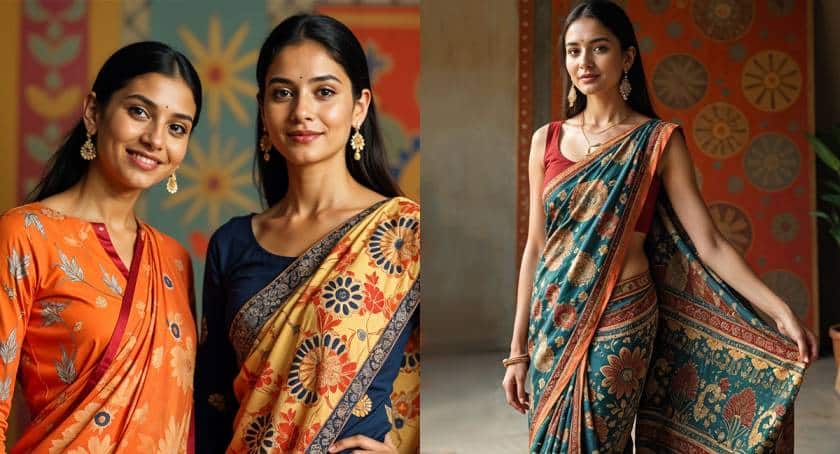Celebrated Saura Art on Fabrics
Odisha, a land celebrated for its rich cultural heritage and traditional arts, is witnessing a fascinating evolution in its fashion industry. Among its many indigenous art forms, artisans are now reimagining Saura Art, an ancient tribal painting tradition, on fabrics. This fusion of heritage and modernity redefines Odisha’s textile landscape, drawing attention from designers, fashion enthusiasts, and culture aficionados alike. The transformation of Saura Art from a sacred wall painting tradition to an innovative textile design represents a new chapter in Odisha’s artistic legacy.
The Origins of Saura Art
The Saura tribe, one of Odisha’s oldest indigenous groups, is where Saura art emerged. Traditionally, this art form was an integral part of their religious and ceremonial practices. Known as “Ikons,” artisans created these paintings on homes’ mud walls, embedding them with deep spiritual significance. The motifs typically depicted nature, daily life, and mythological narratives, often symbolizing the tribe’s strong connection to their environment.
Saura paintings feature complex geometric patterns and human figures engaged in farming, hunting, and dancing. The style is distinctive for its minimalistic yet detailed representations, which use fine lines to create complex compositions. Unlike the more widely known Warli paintings of Maharashtra, which bear some resemblance to Saura Art, Saura paintings are more structured, with a defined narrative flow and spiritual symbolism.
Evolution of Saura Art on Fabrics
Saura Art’s shift from murals to textiles demonstrates its versatility and classic appeal. Embracing this traditional art form in contemporary fashion has been driven by artisans and designers who recognize its aesthetic and cultural value. This transition has allowed Saura Art to reach a wider audience while preserving its authenticity.
Artisans have employed several techniques to transfer Saura Art onto fabrics, including:
- Hand-Painting: Many artisans continue to hand-paint Saura motifs onto fabric using natural dyes or acrylic colors. This technique guarantees that no two designs are alike and that every component is distinct.
- Block Printing: Block printing has emerged as a popular technique for replicating Saura designs on textiles. Wooden blocks carved with Saura patterns are dipped in dyes and stamped onto fabrics, creating complex and repetitive designs with precision.
- Embroidery and Appliqué: Some designers incorporate Saura figures through embroidery and appliqué techniques, adding texture and depth to the fabric. This approach blends Saura Art with other traditional Odia textile arts, resulting in unique hybrid creations.
The Ideal Fabrics for Saura Art
The success of Saura Art in fashion is primarily due to its seamless integration with various textiles. Some of the most commonly used fabrics include:
- Cotton: Lightweight, breathable, and versatile, cotton is an ideal canvas for Saura designs. People highly seek cotton sarees, kurtas, and dupattas featuring Saura motifs for comfort and artistic appeal.
- Silk: Silks such as Tussar and Sambalpuri silk are often adorned with Saura motifs, adding a luxurious touch to ethnic wear. The fusion of tribal art with the richness of silk creates a perfect blend of tradition and sophistication.
- Handloom Fabrics: Odisha’s renowned handloom textiles, such as Ikat, Bomkai, and Kotpad, provide an excellent foundation for Saura-inspired designs. The fusion of these crafts showcases the state’s diverse textile heritage while promoting sustainable fashion.
The Rise of Saura Art in Fashion
The increasing demand for sustainable and handcrafted fashion has contributed to the resurgence of Saura Art. Designers are now integrating these motifs into their collections, combining traditional aesthetics with modern styles. Some notable trends include:
- Saura-Printed Sarees: Saura art significantly impacts ethnically, particularly in sarees. Bold Saura motifs adorning the pallu and borders have become a fashion statement, appealing to those who appreciate cultural artistry.
- Fusion Wear: Indo-western outfits featuring Saura prints, such as tunics, skirts, and jackets, are gaining popularity among younger fashion enthusiasts. These clothes provide the ideal balance of modernism and tradition.
- Accessories and Home Décor: Besides clothing, designers now use Saura designs on handbags, scarves, cushion covers, and wall hangings. This expansion has allowed the art form to transcend fashion and enter the realm of lifestyle and home décor.
Role of Artisans and Sustainable Fashion
The revival of Saura Art on fabrics is not merely a fashion trend but also a movement that supports local artisans and promotes sustainability. Several programs empower Saura artists by giving them venues to display their abilities and generate a steady income.
Additionally, as consumers become more conscious of ethical fashion, Saura Art aligns with slow fashion principles. Handmade, eco-friendly textiles reduce the environmental impact of mass production while preserving a valuable cultural tradition.
Challenges and the Way Forward
Despite its growing popularity, the commercialization of Saura Art on fabrics faces several challenges:
- Preserving Authenticity: With rising demand, the art form risks losing its authenticity. It is crucial to ensure that artisans remain the primary creators and custodians of Saura Art.
- Market Reach: Many rural artisans lack direct access to national and international markets. Bridging this gap through online marketplaces, craft fairs, and designer collaborations can enhance their visibility.
- Counterfeit Products: The emergence of machine-printed Saura imitations threatens the uniqueness of handcrafted designs. Educating consumers about the value of handmade art can help protect the integrity of the craft.
Final Thoughts
Saura Art on fabrics is more than just a fashion trend—it is a movement that bridges the past and the present. By integrating this ancient tribal art into contemporary fashion, Odisha’s designers and artisans create a distinctive identity in the textile industry. This evolution not only celebrates the rich heritage of Saura Art but also aligns with global efforts towards sustainable and ethical fashion.
As the appreciation for handcrafted textiles grows, Saura Art is poised to gain international recognition. By supporting this artistic movement, we contribute to a more meaningful and ethical fashion industry while preserving the cultural legacy of one of Odisha’s most treasured indigenous art forms. The future of Saura Art in fashion is bright, promising endless possibilities for creativity, innovation, and global appreciation.


